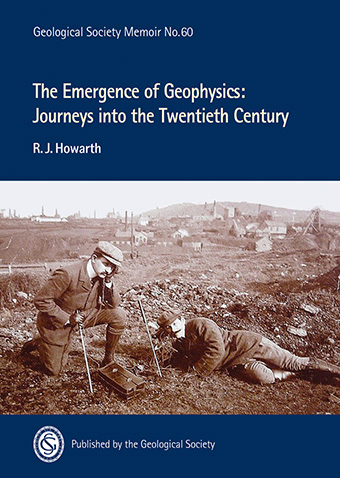
The Emergence of Geophysics: A Journey into the Twentieth Century
Product code: M0060
Print publication date: 27/11/2024
Geological Society of London, GSL Memoirs, Geophysics and Geophysical Applications
Type: Book (Hardback)
Binding: Hardback
ISBN: 9781786206251
Author/Edited by: By R.J. Howarth
Weight: 1.65kg
Number of pages: 438
Online publication date: 23/11/2024
Lyell Collection URL: https://www.lyellcollection.org/toc/mem/60/1
£130.00
Log in for your member priceFull Description
Memoir 60
How did geophysics begin? Who were the pioneers of this new science? What instruments did they devise to measure the Earth-related phenomena they were interested in? This Memoir attempts to answer such questions in a well-illustrated, and largely non-technical, account. The seventeenth century saw magnetism used as an aid to prospecting for iron ore in Sweden, and Isaac Newton’s derivation of the law of gravitational attraction. A gradually increasing interest in ‘physics of the Earth’ brought forth the new discipline of ‘geophysics’ in the early nineteenth century and, by the end of the following century, airborne and satellite-based investigations had become routine. The Emergence of Geophysics explores this evolution in several parallel strands: terrestrial magnetism and electricity, gravity, seismicity, heat, geodynamics and radioactivity, broadly reflecting the timing of their introduction as tools aiding geophysical studies. Biographical information is included for many of its practitioners and the book should be of interest to both geophysicists and to anyone interested in the history of Earth science.
Published online on the Lyell Collection 25 November 2024. The online content for this title is Open Access.
Acknowledgements
Chapter 1. Introduction
1.1 Raison d’etre
1.2 A language for new sciences
1.3 Quantifying the evolution of ‘geophysics’
1.4 Geophysical journals
1.5 Bibliographical note
Chapter 2. Terrestrial magnetism I. Understanding the magnetic field – from mystification to quantification
2.1 Lodestones and the earliest magnetic compasses
2.2 The terrella
2.3 Gilbert’s treatise
2.4 Magnetic declination
2.5 Long-term changes in declination
2.6 Halley’s four-pole model
2.7 Daily changes in declination
2.8 Magnetic inclination
2.9 Magnetic intensity
2.10 A technological breakthrough
2.11 Coulomb’s torsion balance
2.12 Magnetic currents
2.13 Changes in magnetic force in time and space
2.14 Legendre, Gauss and the method of least squares
2.15 Gauss and geomagnetism
2.16 Final proof of the inverse-square law
Chapter 3. Terrestrial magnetism II. Into the field
3.1 Geomagnetic maps and the terrestrial magnetic field
3.2 Changes in the field with time
3.3 Rock magnetism
3.4 Mineral exploration
3.5 Return to the sea
Chapter 4. Applied electrical and electromagnetic methods
4.1 Natural earth-currents and self-potential
4.2 Artificial currents and the search for ore
4.3 Electro-magnetic prospecting begins
4.4 From radio to radar
4.5 From ore-bodies to salt domes
4.6 Minerals again
Chapter 5. Gravity surveying and the ‘Figure of the Earth’ from Newton to CHAMP
5.1 The length of a seconds pendulum
5.2 Arc lengths and ellipticity
5.3 Spheroid shape and pendulum measurements
5.4 The attraction of mountains
5.5 The torsion balance and other methods
5.6 Gravity corrections, regional gravity-mapping and the concept of isostasy
5.7 From the Eötvös torsion-balance to the gravimeter
5.8 Pendulums at sea
5.9 The arrival of the gravimeter
5.10 Vibrating strings
5.11 Free-falling corner-cubes
5.12 Superconduction
5.13 Borehole gravimetry
5.14 Airborne gravimetry
5.15 Gravity gradiometers
5.16 Into space
Chapter 6. Shaking the Earth: from volcanology to seismic surveys
6.1 Volcanoes
6.2 Earthquakes
6.3 Mapping the frequency of earthquake occurrence
6.4 Earthquake distribution in time
6.5 Instrumental detection of earthquakes
6.6 Earthquake magnitude
6.7 The modern era
6.8 Locating the origin of an earthquake
6.9 Understanding the deep Earth
6.10 The beginnings of seismic prospecting
Chapter 7. The heat of the Earth
7.1 Early history of heat-measuring instruments
7.2 Near-surface geothermal measurements
7.3 Temperatures in mines and deep boreholes
7.4 Heat-flow through the continents and the seafloor
7.5 How to explain the Earth’s heat?
Chapter 8. Aspects of geodynamics
8.1 From mechanics to the solid Earth
8.2 A layered Earth
8.3 The enigma of mountain chains
8.4 The viscosity of the Earth
8.5 Isostasy
8.6 Have the continents moved?
8.7 Convection within the Earth
8.8 Tides, tilts and strains
Chapter 9. Radioactivity
9.1 From waste-tip to colourant
9.2 Early sources of uranium
9.3 Early sources of thorium
9.4 Towards radioactivity
9.5 Early investigations: radioactivity in nature
9.6 Development of measuring instruments
9.7 The search for uranium
9.8 Nuclear well-logging
9.9 The source of the Earth’s heat
9.10 Geochronology
Subject index
Person index
Howarth provides a deep view of the history of those geophysical sciences of the 19th and 20th centuries bordering most closely on geology, a task for which he is well qualified. He studied geology in the 1960s, he taught the application of statistics to geology for thirty years, and he has published broadly on mathematical geology. In a series of journal articles he has also used this expertise to examine the often unexplained quantitative methods used to map Earth’s magnetic declination in the 18th century. He also applied his extensive background in graphical methods in the geosciences to the history of mineralogy and petrology. In short, Dr. Howarth is a geologist with historical sensibilities and an eye for the roles of mathematics and physics in geological development. This important book culminates decades of historical research.
Gregory A. Good (West Virginia University, U.S.A)
Excerpt from review originally published in the International Union of Geological Sciences journal Episodes, August 2025.



